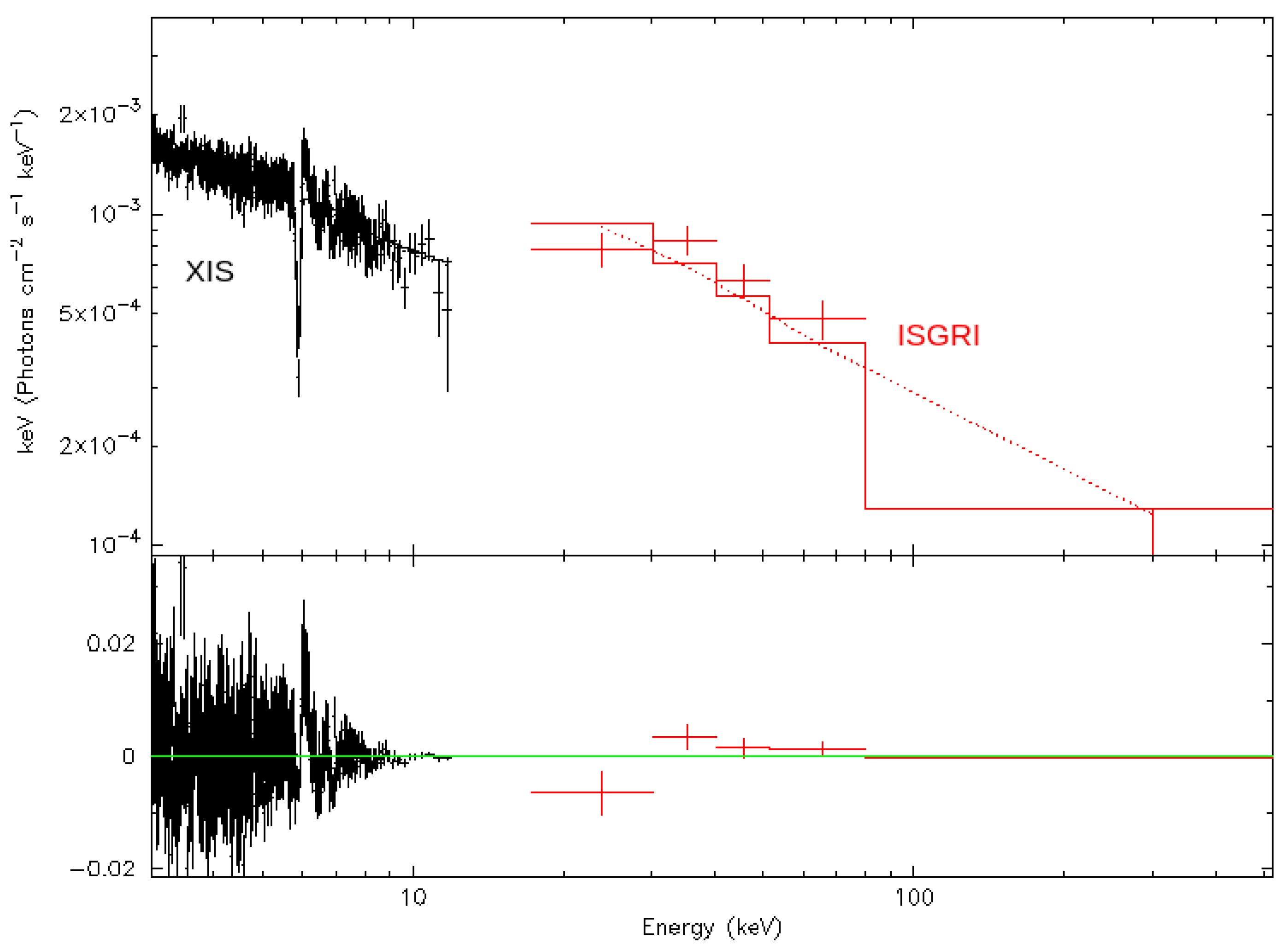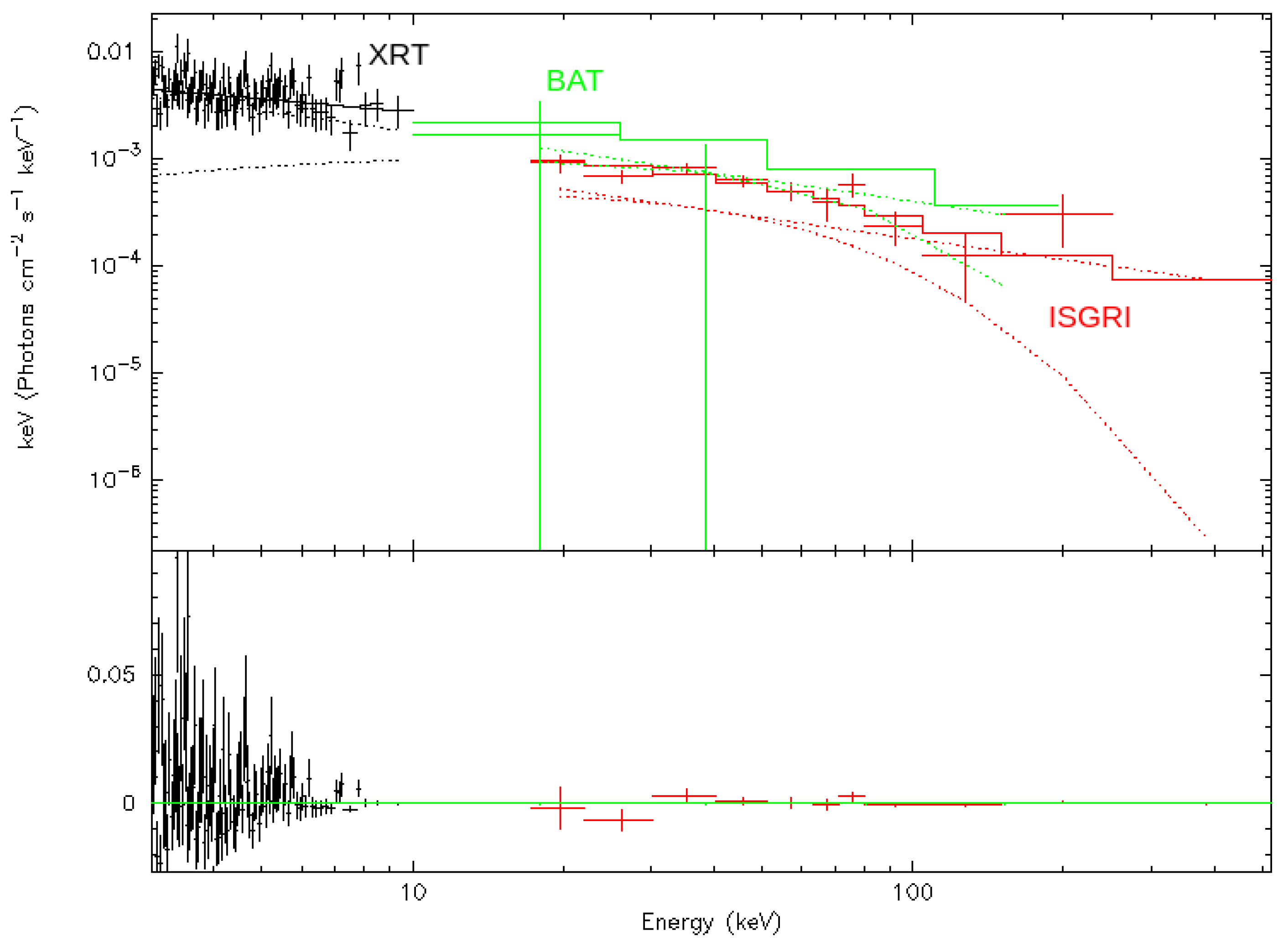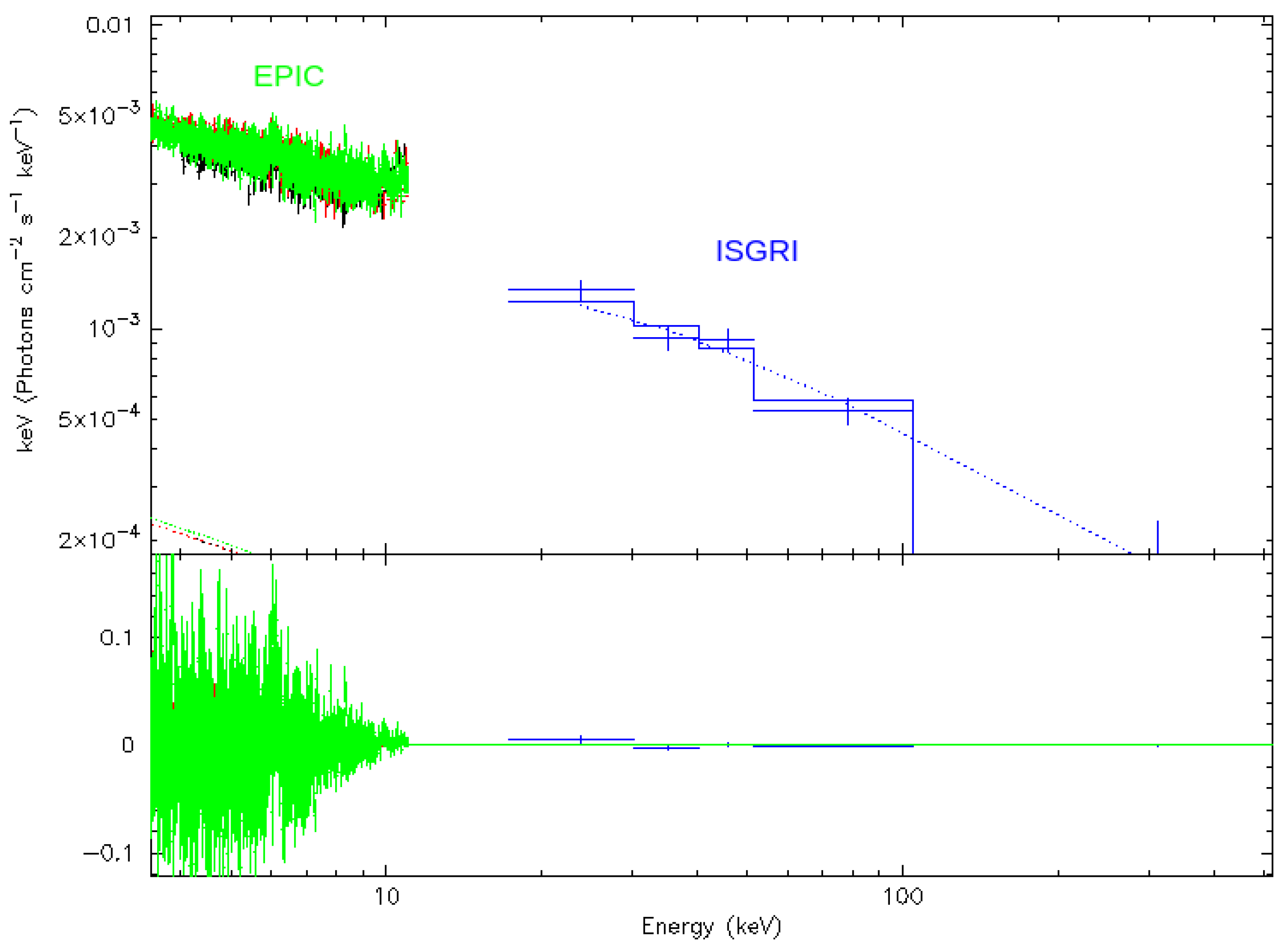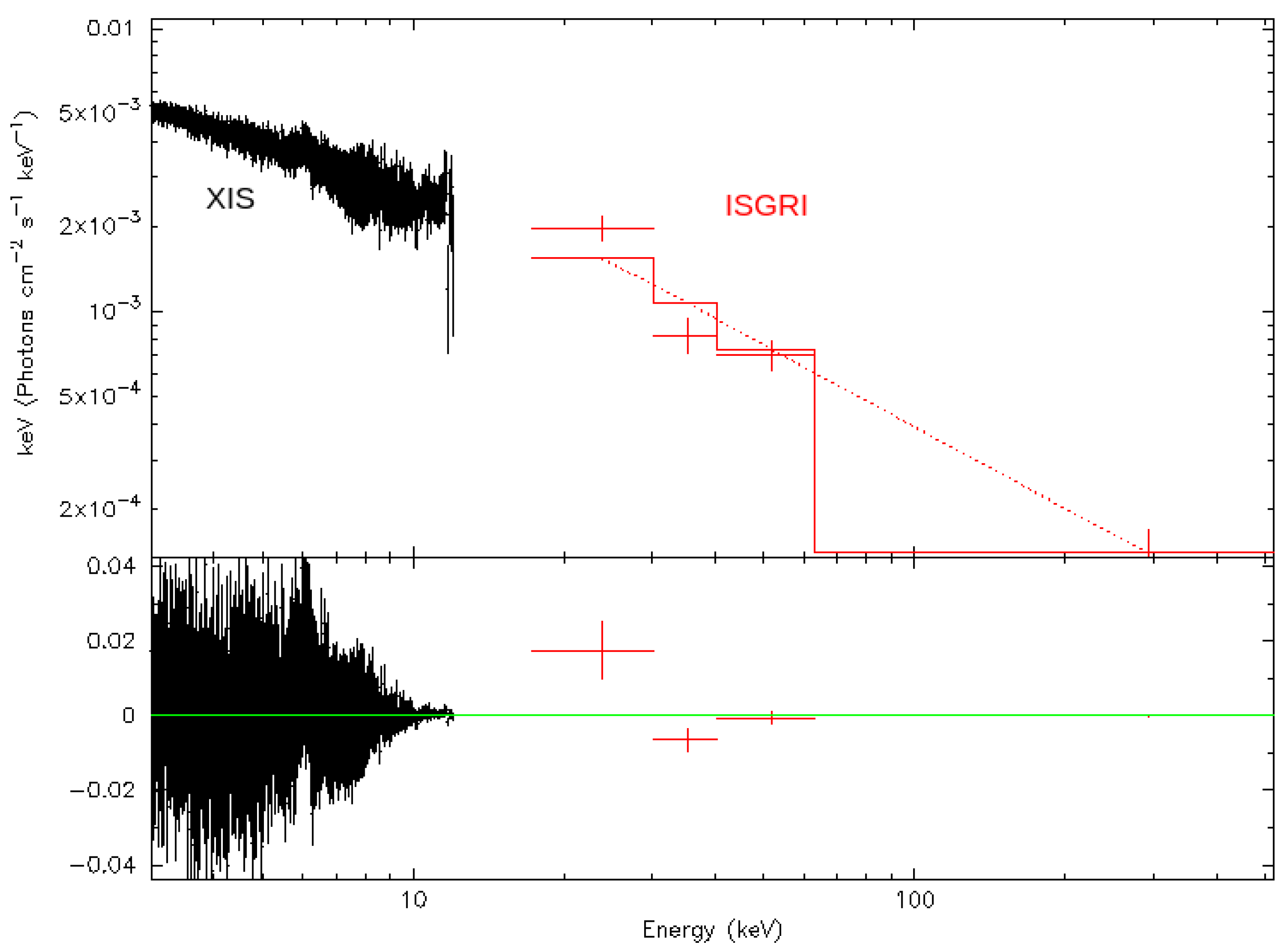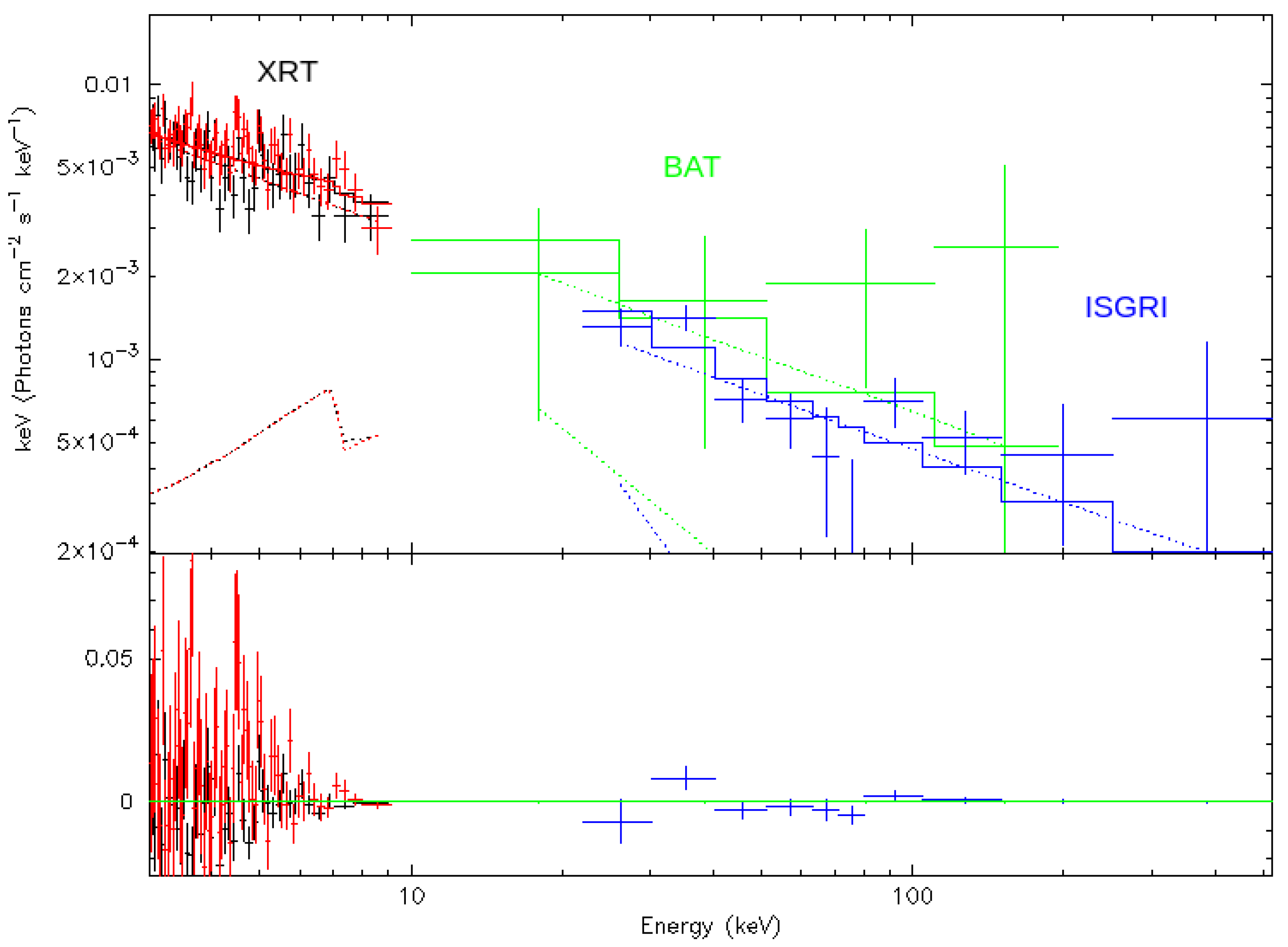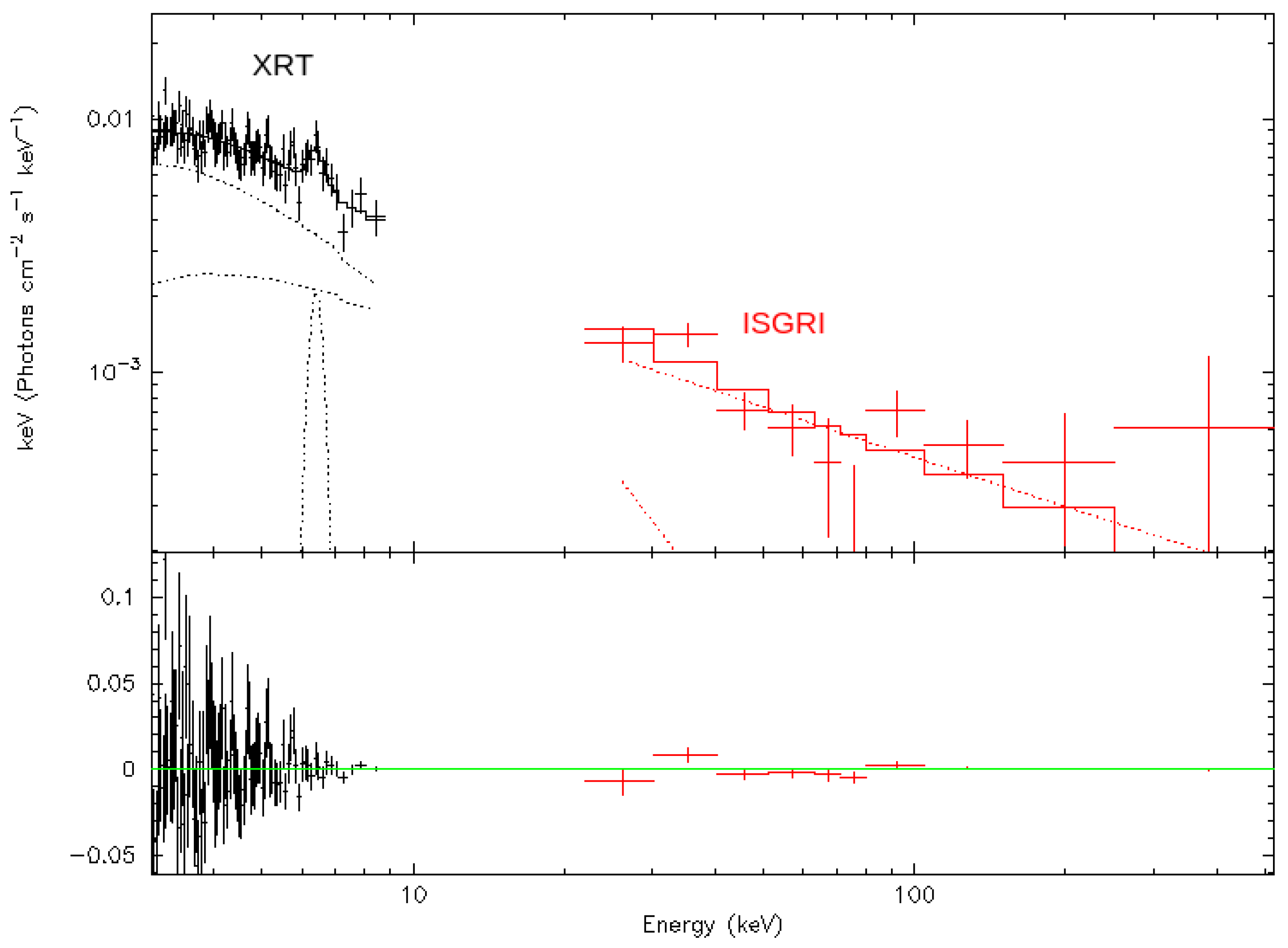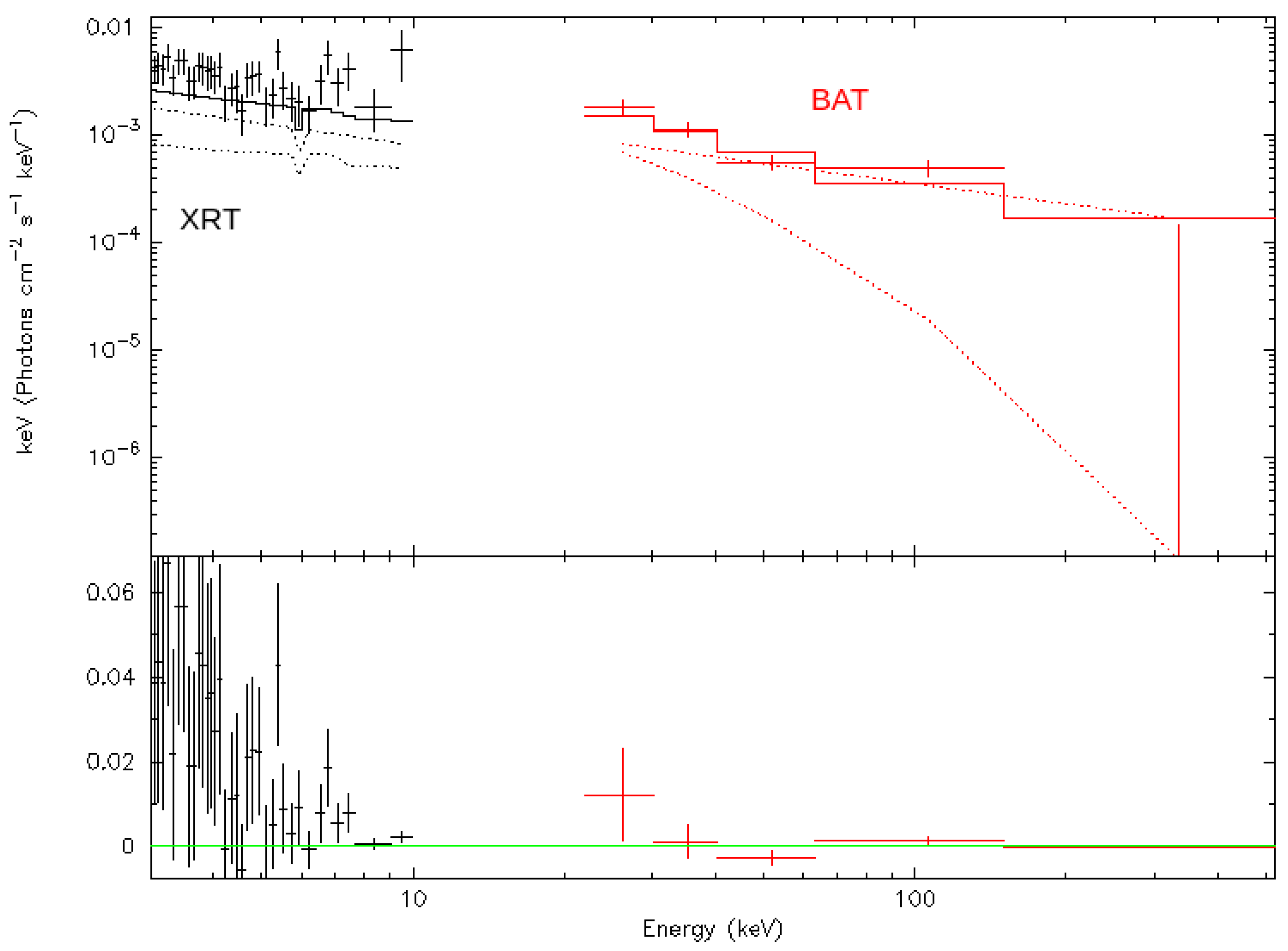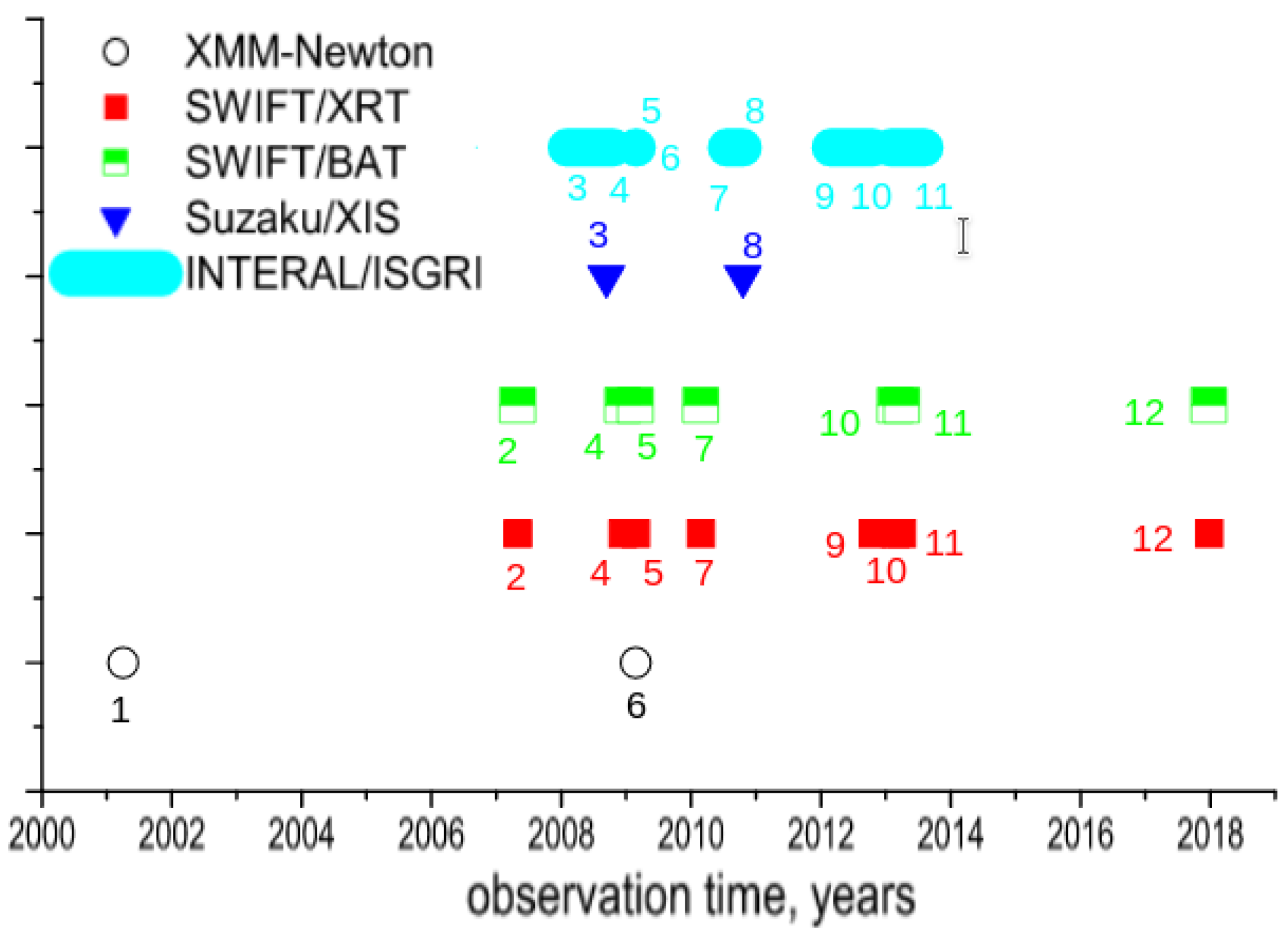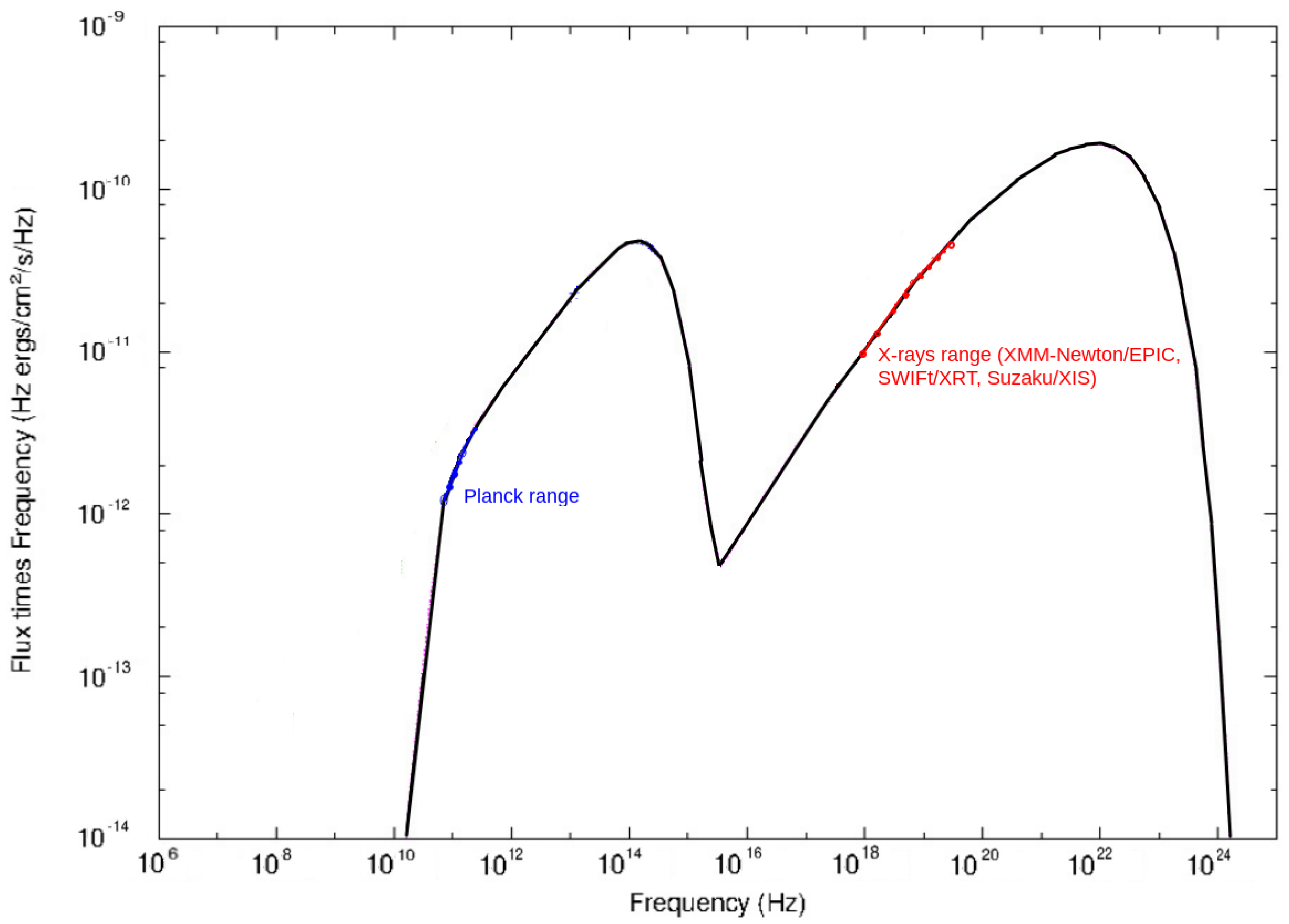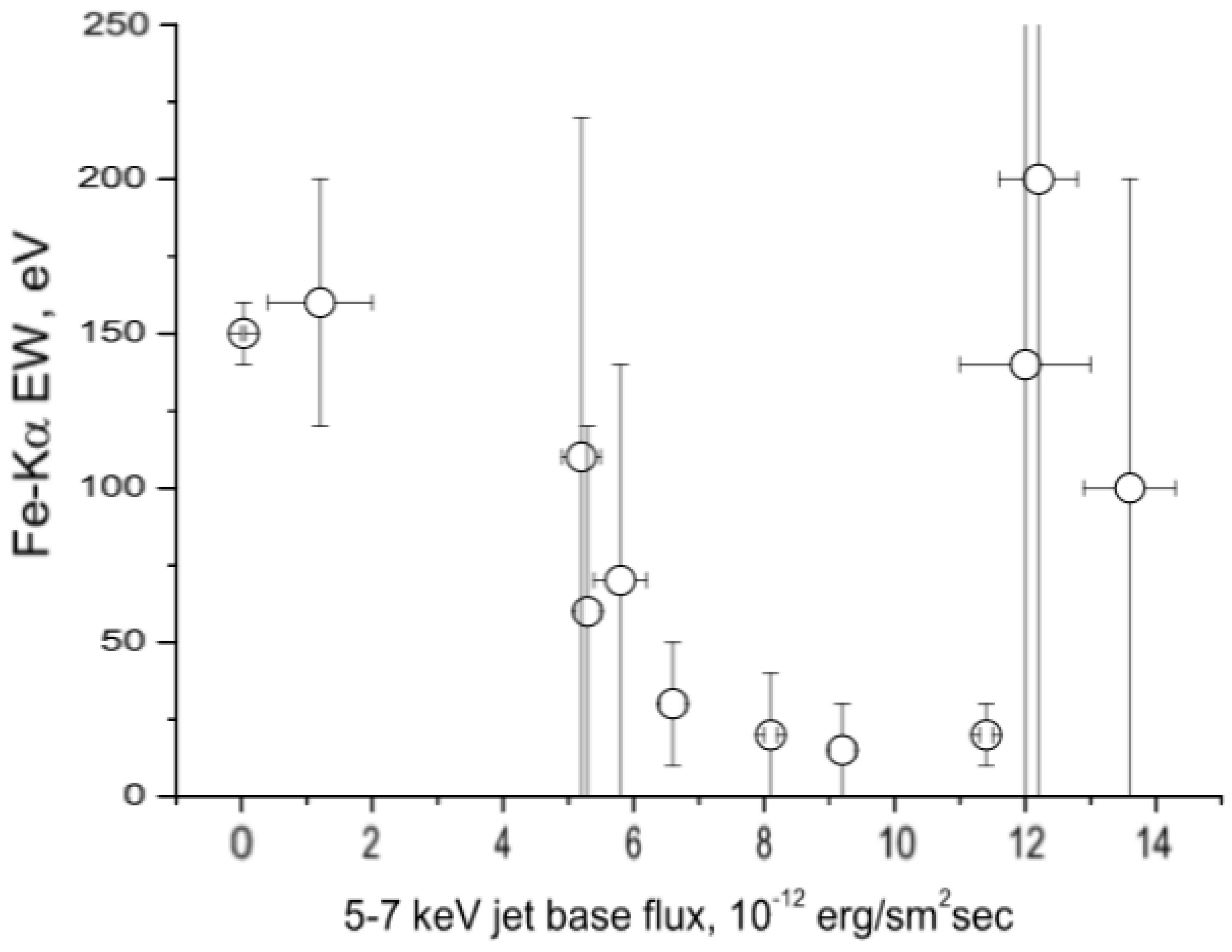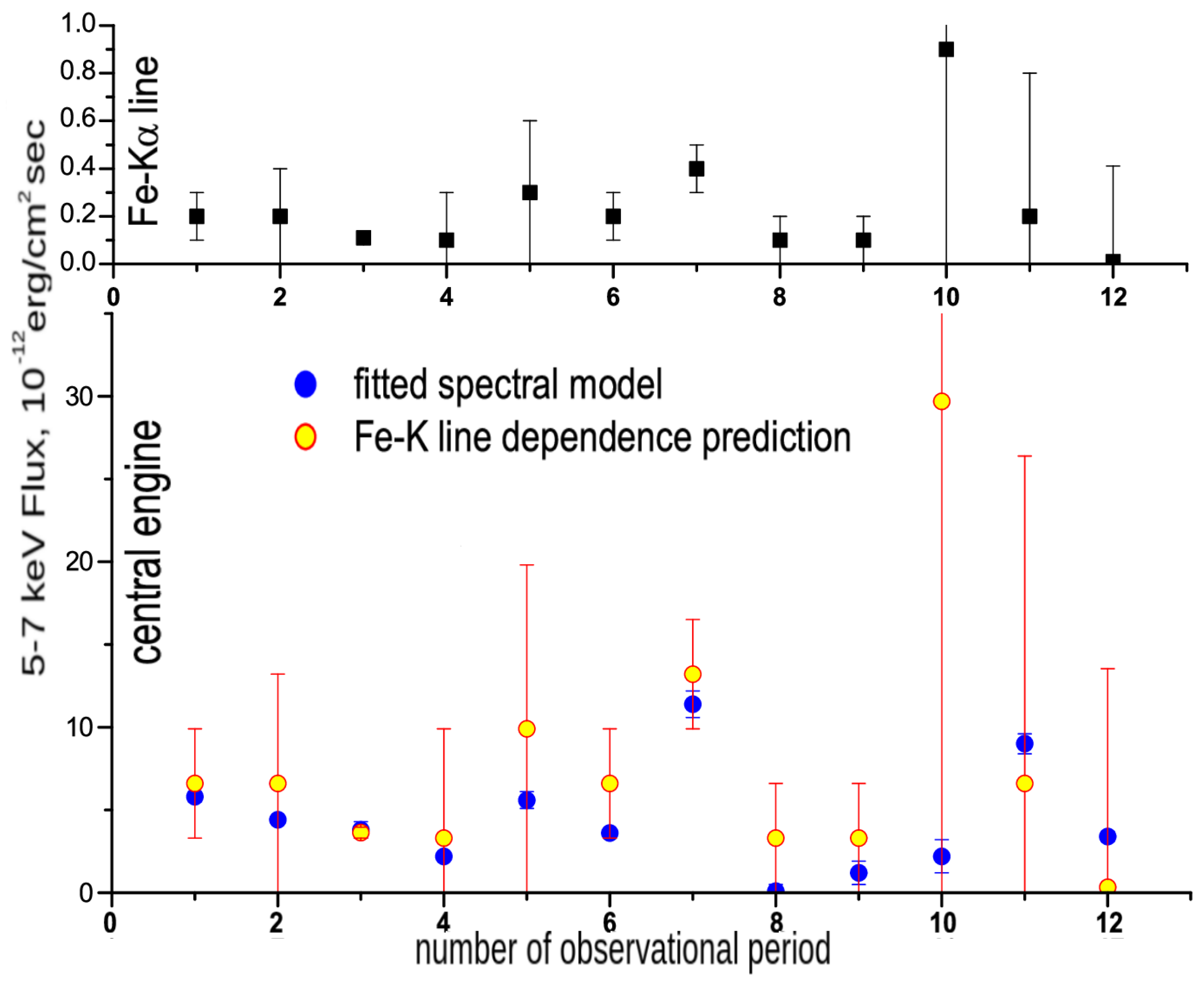1. Introduction
The fact that active galactic nuclei (AGN) can manifest itself as radio loud (RL) or radio quiet (RQ) is clearly known from 1989 when in Reference [
1] the criterion of radio loudness was formulated. This criterion is based on radio-to-optical brightness relation
where
is the AGN luminosity in radio frequencies (usually at 5 GHz) and
is its luminosity in blue optical light band (near 689 THz)
means that the object is RQ;
corresponds to an RL AGN.
can be referred to as radio moderate (RM). The last class with strong variations of radio loudness from typically RL to RQ values and unstable jets is becoming more common in the last decade is radio transitional (RT), see Reference [
2]. RT AGN possibly have variable spectral shape similarly to X-ray binaries [
3,
4,
5]. An object of our investigation 3C 111 likely belongs to this class rather than to RL one, as well as several other AGNs including the famous 3C 120 [
6].
Since that time we know that RQ AGN are 10–20 times more frequent than RL ones. However, the question of the physical difference in AGN “central engine” leading to particular radio properties, is still quite away from the final answer.
Historically, there were several attempts to interpret the RL/RQ dichotomy in different terms. Firstly, the geometrical scheme was proposed for this in Reference [
7] similarly to the “unification scheme” of Sy1-Sy2 AGN. But the fact that RL AGN, as well as RQ ones, can belong to Sy1 or Sy2, or either intermediate class as well, has disproved this hypothesis [
8,
9]. Later there was an attempt to trace out the link between the central black hole (BH) mass and radio loudness [
10]. However, again it was shown that despite the AGN with more massive BHs usually have more powerful jets as well—in comparison with AGN hosting lighten ones, there is no direct dependence between BH mass and presence of jets. Moreover, AGN with massive BHs can be RQ as well [
11].
One of modern schemes explaining the RL/RQ dichotomy is known today as “spin-paradigm” or “gap-paradigm”. First version of it was proposed in Reference [
12]; see also Reference [
13] and references therein. They interpreted the difference between RQ and RL AGN as the result of different values of the central BH spin, adopting the Blandford-Znajek (BZ) scheme of jet formation [
14]. This scheme has been extended to the case of retrograde accretion disk rotating in the direction opposite to the BH spin, referred to as “spin-paradigm” in Reference [
15] and later as “gap-paradigm” [
16].
The central BH spin have significant effect on the shape of emission lines formed in its vicinity. This opens a possibility to test the spin/gap paradigm using the observational data in X-rays concerning the luminescent K lines (first of all Fe-K
near 6.4 keV, and then Ni-K
near 7 keV). Additionally the reflection-based spin definition can be performed using the continuum fitting of the high enough quality spectra [
17]. However many AGNs with high enough values of BH spin appeared to be in fact RQ ones (for instance, NGC 4051, RQ AGN with the central BH spin s > 0.99, as well as RBS 1124 with s > 0.978 and MCG-6-30-15 with s > 0.98). This definitely tells us that there is an another factor implying on the radio loudness besides the spin of its central massive BH, namely, magnetic field flux [
17,
18].
There is the other scheme of jet formation that does not connect the jet activity with the BH spin values—Blandford-Payne (BP) jets [
19]. The disk in RL AGN with BP jets is “truncated” with inner radius of the order of ∼200
[
20,
21], where
is the radius of the innermost stable circular orbit for the Kerr metric.
Within these scenarios, the central parts of the accretion disk (up to the radii of 100–200
) must be radiatively ineffective anyway [
22] either due to disk disruption or high ionization level. This leads to the specific predicted differences in spectral shape between RQ and RL AGN [
23]. Namely, typical RL AGN spectrum is suspected to be harder in comparison with an RQ one with low value of an exponential high-energy cut-off (i.e., below 100 keV) [
23]. The values of high-energy cut-off in an RQ AGN spectrum is suspected to be above 100 keV.
However, in presence of the jet base radiation the high-energy cut-off may be absent in the total spectrum. This can explain some AGN spectral shapes that do not directly correspond to the RQ-RL predictions. In our previous work [
24] we formed a list of such AGN and denoted them as “peculiar” as the value of high-energy cut-off obtained for this RL AGN was near 170 keV. One of the AGN of this list is 3C 111 considered in this paper.
Note that even higher value of high-energy cut-off (near 220 keV) has been obtained in Reference [
25]. Moreover in the NuSTAR observations of AGN populations no links were found between high energy cut-off and Eddington ratio, or BH mass [
26,
27]. Recent analysis of samples of non-blazar RL and RQ AGN of Swift/BAT catalogue also revealed that the photon indices and high-energy exponential cut-offs of RL and RQ AGN cover the same range of values and do not show significant differences between their distributions [
28]. This addresses the questions both about physical conditions causing the cut-off absence in RL AGN or low values of cut-off in RQ ones. Here we consider the RL AGN case supposing that the possible reasons of high values or even absence of high energy cut-off in its spectra connected with the jet contamination. In the next subsection we briefly describe the object of our investigation, RL S1 AGN 3C 111.
3C 111 is quite nearby elliptical broad-line radio galaxy with the redshift z = 0.0485; alternative name 3EG J0416+3650 [
29], hosting the non-blazar radio-loud AGN of Sy1 type [
30], with FRII type of radio morphology (double lobes with hot spots, but with single one-side jet [
29]). The central BH mass is estimated around 2 × 10
M
(see, e.g., Reference [
31] and references therein).
First X-ray observations of 3C 111 by ASCA [
32] detected weak Fe K
line. Later Suzaku and XMM–Newton observations [
33] disclosed emission/absorption variability and weak reflection features. They also detected the Fe K complex. The jet component was probably dominating in the hard X-ray emission during their observable periods, as the high-energy exponential cut-off was not found in the Suzaku/HETG spectrum.
The spectral analysis of the Suzaku/XIS data was performed also in Reference [
34] who detected the variability of an ultra-fast outflow on ≈7 days timescale, an ionized Fe emission line in the first observation, and a blueshifted absorption line in the second one, when the flux is ≈30% higher. They stated that the location of this ionized material is constrained at ≈0.006 pc and it belongs to the accretion disc at ≈20–100
from the central black hole and a highly ionized and massive ultrafast outflow with velocity ≈0.1 c, respectively.
Also, in Reference [
31] it was performed a detailed investigation of a connection between the accretion disk and events in the jet in 3C 111. They pointed out that the X-ray continuum flux and Fe K line intensity are strongly correlated with a time lag less than 90 days.
An attempt to distinguish between the thermal vs. non-thermal high energy emission of 3C 111 has been performed in References [
25,
35] relying on the 0.4–200 keV composite spectrum from Suzaku, INTEGRAL and Swift/BAT data, as well as
Fermi-LAT
-ray data and radio together with the infrared data. The results of the pexrav spectral model [
36]: photon index
= 1.68 ± 0.03, high-energy cut-off
= 227
keV, reflection parameter
R = 0.7 ± 0.3; the Gaussian emission line near 6.4 keV was characterized by equivalent width EW = 85 ± 11 eV, that is, the thermal part was dominating in the X-ray spectrum during their observational period. Their radio to
-ray spectral energy distribution was successfully fit to the single-zone synchrotron self-Compton (SSC) model.
Recently the combined Chandra/HETG and XMM-Newton/RGS observational data on 3C 111 were analyzed in Reference [
37]. They has confirmed an excess of neutral absorption with respect to that estimated from 21 cm radio surveys of atomic HI in the Galaxy [
38]; they also detected a weak (EW = 16 ± 10 eV) Fe K
emission line at
E = 6.4 keV.
Analysis of the data obtained by VLBA and IRAM within the MOJAVE, UMRAO and F-GAMMA programs revealed the outburst activity and parsec-scale structural variability [
39]. Following the results of the mm-VLBI, the object 3C 111 passed in 2007 the flux density outburst stage [
40]. On the parsec scales, the outburst is resolved into a number of plasma components forming an intriguing bent structure. The spectacular wide-band radio-IR-X-ray observations of the kpc-scale jet in 3C 111 [
41] revealed important differences between the knot morphology in the radio, X-ray and near-IR bands and interpreted them as a sign of two-component synchrotron model. Recently polarimetric VLBA observations of 3C 111 were analyzed in Reference [
42] and the propagating polarized features in 3C 111 were interpreted as the result of the interaction of shocks in the underlying flow. Recent analysis of GMVA 86 GHz data from Reference [
43] disclosed remarkable radio outburst activity in 3C 111 in 2007.
In this paper we make use of all X-ray data on 3C 111 available publicly in SWIFT, INTEGRAL, XMM-Newton and Suzaku data archives by the date 5 March 2019. To fix the parameters of the synchrotron emission of the jet base in 3C 111 we also use the Planck spectrum within the wavelength range of 10
–10
Å. The paper structure is as follows: In
Section 2 we describe the X-ray observational data used in our work and its reduction. In
Section 3 we describe two methods we propose to distinguish between the spectral components induced by jet base and accretion disk/corona. In the
Section 4 we present the results of spectral fitting. Finally, in the
Section 5 and
Section 6 we discuss our results and draw out the conclusions.
3. Two Ways to Distinguish between Nuclear and Jet Base Spectral Components
Jet base (of a percent of pc in size) is composed mainly of ultrarelativistic electron-positron (hereafter electron) plasma ejected at relativistic bulk velocity from the AGN central region. Being accelerated at shock fronts inside the jet, these electrons emit synchrotron radiation visible at a wide range of wavelengths from radio to ulraviolet. These accelerated electrons/positrons in the most cases are distributed over the energies following power-law dependency
[
44]. Such distribution of charged particles generates self-absorbed synchrotron emission with spectral distribution:
where
is the break frequency at which an optical depth is
.
If the source is transparent enough or if we consider the frequency range above the break frequency of our object,
, this formula can be approximated with the simple power-law dependency with the slope
, where
is the photon index [
45,
46,
47]:
At frequencies well below 1 GHz free–free synchrotron self-absorption flattens the overall spectrum. For 3C 111 in our situation we have 24–240 GHz Planck working range and thus we can use the approximate power-law Formula (
2).
As it was shown by Reference [
47], the jet X-ray self-Comptonized synchrotron (SSC) or Inverse Compton (IC) spectra have the same photon index as the synchrotron emission of the jet at radio wavelengths. Thus one can apply the same power-law photon index value to fit the X-ray SSC/IC and radio synchrotron emission spectra of the jet base. Taking into account that at radio frequencies the jet emission of an RL AGN is many times more intensive than the emission of other AGN components their contribution to the AGN radio spectrum is also negligible in comparison with the jet one. This makes the radio band more promising for estimation of the parameters of the synchrotron emission of the jet base. The following spectral model of 3C 111 jet emission from radio to X-rays was shown in Reference [
25]; here we show their one zone SSC model with radio (Planck) and X-rays (Swift/XRT, XMM-Newton/EPIC and Suzaku/XIS) working ranges to illustrate the method we use here to determine the jet spectral counterparts (
Figure 2).
In this view we propose to separate the contribution of the jet base and disk/corona based on the equality of synchrotron and SSC/IC slopes. Namely, we use for the jet base component of our X-ray spectral model the frozen values of the photon index that is equal to that obtained from the Planck spectrum of 3C 111 in the range of 24–240 GHz. The Planck radio spectrum was fitted with a simple power-law model with the photon index = 1.66 ± 0.06. Anyway, we here make the hypothesis about the slope and show that it allows us to reduce the tension concerning the values of the high energy cutoff.
The second way we discuss here, is an use some additional information obtained from in Fe K line emission. Fe K lines emission formed in the accretion disk of an AGN is correlated with the primary nuclear continuum emitted by accretion disk/corona. Here we presume a linear dependence between Fe-K line and primary nuclear emission fluxes.
In case of better quality data this information can serve as the basis for an alternative approach to separate the nuclear flux from the jet contributions, which presupposes that some relativistically broadened lines be present in the AGN spectrum and their equivalent width is variable.


